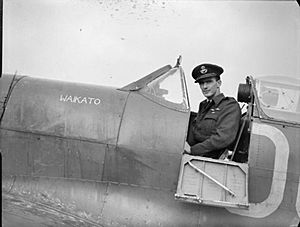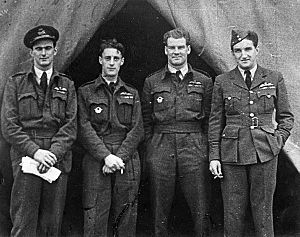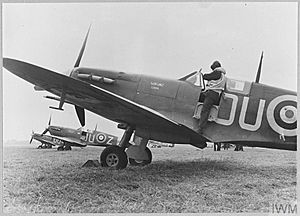Edward Wells (RNZAF officer) facts for kids
Quick facts for kids
Edward Preston Wells
|
|
|---|---|

Wells, sitting in the cockpit of a Spitfire Mk. Vb named for one of the provinces of New Zealand
|
|
| Nickname(s) | Hawkeye |
| Born | 26 July 1916 Cambridge, New Zealand |
| Died | 4 November 2005 (aged 89) England |
| Allegiance | New Zealand |
| Service/ |
Royal New Zealand Air Force (1939–1947) Royal Air Force (1947–1960) |
| Rank | Group Captain |
| Commands held | RAF Bawdsey Day Fighter Leaders' School West Malling Wing Detling Wing Tangmere Wing Kenley Wing No. 485 (NZ) Squadron |
| Battles/wars | Second World War
|
| Awards | Distinguished Service Order Distinguished Flying Cross & Bar |
Group Captain Edward Preston Wells DSO, DFC & Bar (born 26 July 1916 – died 4 November 2005) was a brave New Zealand flying ace during the Second World War. He flew for the Royal New Zealand Air Force (RNZAF) and was known for shooting down many enemy aircraft. He is officially credited with destroying twelve enemy planes.
Wells joined the RNZAF in 1939. After his flight training, he went to the United Kingdom to fly with the Royal Air Force (RAF). He flew powerful Supermarine Spitfires during the Battle of Britain. Later, he led No. 485 (NZ) Squadron. For much of 1943 and 1944, he commanded groups of fighter planes called "wings" over England and France. By the end of the war, he was in charge of a special school for fighter leaders. After the war, he joined the RAF and held important positions until he retired in 1960. He then became a farmer and later moved to Spain to grow fruit. He passed away in 2005 at the age of 89.
Contents
Early Life and Training
Edward Preston Wells was born in Cambridge, New Zealand, on 26 July 1916. His father was a farmer. Edward went to Cambridge High School and then worked on a farm himself.
In 1938, he became a car salesman in Auckland. Later, he managed a car yard in Hamilton. He was a very good shot, especially at clay-bird shooting, which earned him the nickname 'Hawkeye'.
In October 1938, Wells applied to join the Royal New Zealand Air Force (RNZAF). He was accepted in April 1939 and started his training six months later. He learned to fly at different schools in New Zealand and earned his pilot's wings on 23 April 1940.
Second World War Adventures
When Wells finished his flight training, the Second World War was already happening. As a pilot officer, he was sent to England to join the Royal Air Force (RAF). He sailed from New Zealand in June 1940 with 22 other New Zealand pilots.
Once in England, he trained to fly Supermarine Spitfires. His first job was with No. 266 Squadron in August.
Fighting in the Battle of Britain
Wells joined No. 41 Squadron on 2 October 1940. This squadron was very busy, flying from Hornchurch and often scrambling to meet German air raids. On his second day, his Spitfire was badly damaged in a fight with German Messerschmitt Bf 109 planes.
On 7 October, he helped shoot down a Dornier Do 215 bomber. During the later part of the Battle of Britain, he shot down a Bf 109 near Boulogne on 17 October. He probably destroyed another on 29 October and confirmed destroying another Bf 109 on 2 November.
On 11 November, while patrolling over the English Channel, Wells met Italian planes. He was the first British-based fighter pilot to fight them. He damaged one Fiat CR.42 and a Henschel Hs 126. Later that month, he shot down another Bf 109 near Dymchurch. This was one of ten shot down by his squadron that day. In January 1941, he damaged a Heinkel He 111.
Leading the Fight on the Channel Front
In March 1941, Wells joined No. 485 (NZ) Squadron. This was a new unit made up of New Zealand pilots. Wells was one of the most experienced, having already destroyed three enemy planes. The squadron started flying missions in mid-April.
In late June, the squadron began flying offensive missions over northern France. On 5 July, while protecting bombers, Wells shot down a Bf 109. It was the first enemy fighter shot down over France by a pilot from No. 485 Squadron. The German pilot parachuted out. On the way back to England, he shot down another Bf 109. Later that month, he shot down another Bf 109 near Cherbourg. By this time, Wells was a flight lieutenant and a leader in his squadron.
On 19 August, while protecting bombers, Wells got into a big dogfight. He shot down one Bf 109 that was attacking another Spitfire and damaged a second German fighter.
Wells was the most successful pilot in his squadron. At the end of August, he was awarded the Distinguished Flying Cross (DFC). This award recognized his bravery and skill. The official announcement said:
This officer has served with fighter squadrons since May, 1940, and has taken part in many engagements against the enemy. He has destroyed at least five of their aircraft and has damaged others. He has at all times shown the greatest courage and determination.
On 18 September, Wells shot down another Bf 109 during an escort mission. A few days later, he helped his wingman whose plane was damaged. Wells destroyed a Bf 109 that was about to attack his struggling friend. On his way back to England, he was chased by four Bf 109s. He managed to shoot down one of them and escape over the English Channel.
By early November, Wells was still the top flying ace in No. 485 Squadron. He had flown 46 missions over enemy territory. He was awarded a Bar to his DFC, meaning he received the award a second time. The announcement said:
This officer has completed 46 operational sorties over enemy territory He is a splendid leader and a most determined and skilful fighter pilot whose keenness in action sets a splendid example Flight Lieutenant Wells has definitely destroyed 13, probably destroyed 5 and damaged a further 8 hostile aircraft.
Wells became the commander of No. 485 Squadron at the end of November. On 12 February 1942, his squadron flew a mission to stop German fighters protecting two German battleships, the Scharnhorst and Gneisenau, as they moved through the English Channel. Wells's flight attacked one of the small German patrol boats.
The squadron then started facing the new and powerful German Focke Wulf Fw 190 fighter. Wells destroyed one on 16 April and another on 24 April. He damaged another Fw 190 the next day. The following month, he was promoted to acting wing commander and took command of the Kenley Wing, a larger group of squadrons. In August 1942, Wells received the Distinguished Service Order (DSO), a very high award for military leadership. The official announcement said:
This officer has completed many operational sorties. He has destroyed 11, probably destroyed 3 and damaged many more hostile aircraft. His courage, skill and initiative have proved a source of inspiration to his colleagues and his fine leadership has contributed materially to the many successes achieved by the wing.
Later War Service

After two years of continuous flying, Wells was given a break from combat duty. He had flown 133 missions over France. He went back to New Zealand for leave in September 1943. He returned to England in April 1943, visiting aircraft factories in the United States on the way. After a course, he again commanded the Kenley Wing. In August, he married Mary Dorothea de Booy, a Dutchwoman who had escaped from the Nazi-occupied Netherlands.
In November 1943, Wells worked at the headquarters of No. 11 Group, helping with training. In March 1944, he took command of the Tangmere Wing. Within days, he destroyed a German Messerschmitt Me 410 on the ground. He then commanded the Detling Wing and later the West Malling Wing. In November 1944, he became the commander of the Day Fighter Leaders' School. He stayed in this important role until the end of the Second World War.
By the end of the war, Wells was officially credited with destroying 13 enemy aircraft, probably destroying three, and damaging 15. More recent studies suggest his score was 12 destroyed, four probably destroyed, and six damaged, plus the Me 410 destroyed on the ground.
After the War
After the war, Wells continued to lead the Day Fighter Leaders' School. In 1947, he left the RNZAF to join the RAF permanently. He held several important positions with RAF Fighter Command. By 1954, he was the commander of RAF Bawdsey, an air defence radar station. He later worked at the Ministry of Defence before retiring in June 1960 with the rank of group captain.
Later Life
After retiring from the RAF, Wells became a farmer near Woodbridge, England. Later in life, he and his wife moved to Spain. They had an orchard, and Wells became very interested in fruits and the diseases that affected them. He passed away in England on 4 November 2005, at the age of 89. He was survived by his two children. His wife had passed away four years earlier.
Images for kids



